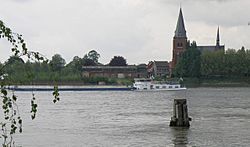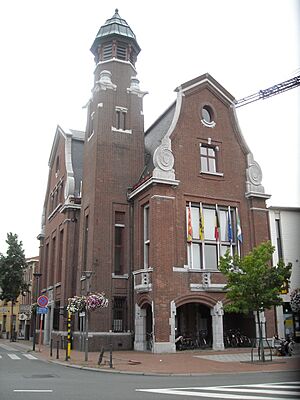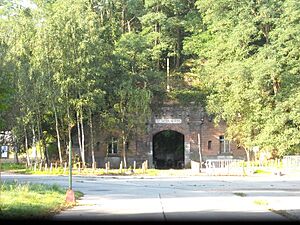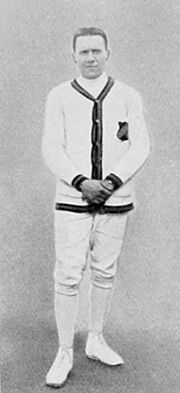Zwijndrecht, Belgium facts for kids
Quick facts for kids
Zwijndrecht
|
|||
|---|---|---|---|
 |
|||
|
|||
| Country | Belgium | ||
| Community | Flemish Community | ||
| Region | Flemish Region | ||
| Province | Antwerp | ||
| Arrondissement | Antwerp | ||
| Area | |||
| • Total | 17.82 km2 (6.88 sq mi) | ||
| Population
(2018-01-01)Lua error in Module:Wd at line 1575: attempt to index field 'wikibase' (a nil value).
|
|||
| • Total | Lua error in Module:Wd at line 1,575: attempt to index field 'wikibase' (a nil value). | ||
| Postal codes |
2070
|
||
| Area codes | 03 | ||
Zwijndrecht is a village and a municipality in Belgium. It is located in the Flemish province of Antwerp. The municipality includes both the village of Zwijndrecht and the village of Burcht. In 2021, Zwijndrecht had a total population of 19,263 people.
Contents
History of Zwijndrecht
What does the name Zwijndrecht mean?
The name Zwijndrecht comes from old Germanic words. These words are "swina drifti." Both "swina" and "drifti" mean "creek." The ending "–drecht" is common in place names north of the Scheldt. This area has many streams and creeks.
Early history of the area
Not much digging has been done in Zwijndrecht itself. However, many old things have been found in the nearby Waasland region. These findings show that people lived in the area a very long time ago. This was around 2200 to 1800 B.C., at the end of the Neolithic Period (Stone Age). Signs of Roman people have also been found in the Waasland.
In the early Middle Ages, Zwijndrecht-Burcht had few people. The land was mostly wet forests and small villages. These villages were separated by woods. This stayed the same until the late 1000s. Then, more people needed more land. The forests were cleared, and fields were made for farming. Farmers used a system where they grew three different crops in rotation. These fields were called "kouters." Over time, paths through wet areas became dikes. By the 1300s, polders (low-lying lands protected by dikes) were used.
Feudal times in Zwijndrecht
On April 15, 1281, the Count of Flanders, Gwijde van Dampierre, gave special rights to Nikolaas van Kets. This made him the Lord of Zwijndrecht. The Lords of Zwijndrecht lived in a manor house called the Kraaienhof. Its ruins were taken down in the mid-1900s. This house was in what is now the village of Burcht.
The van Kets family held these rights until 1445. Then, Wouter van Kets sold them to Jan Vilain. The rights were later passed down to the van Montmorency family. Because of money problems, Filips II de Montmorency had to sell the title and property. He sold them to four cities: Brugge, Gent, Ieper, and the Brugse Vrije. These were known as the "Vier Leden" (four members).
During the Eighty Years' War, these cities fought against Spanish rule. In 1585, they lost their property to the Spanish king. But it was later given back to them. The dikes and other structures were badly damaged during the war. The Vier Leden had to borrow money from Jan van Hove to fix them. When they could not pay back the loan, Jan van Hove became the new Lord of Zwijndrecht-Burcht.
Van Hove held the property until 1621. Then, the Staten van Vlaanderen (the former Vier Leden) paid their debts and got it back. They quickly sold it to an Italian businessman named Jacomo Antonio Carenna. He became the Lord of Zwijndrecht and Burcht. In 1666, he divided the property between his two sons. Jan Francisco Carenna got Zwijndrecht, and Ignacius Carenna got Burcht. Burcht and Zwijndrecht became separate villages. They stayed separate until 1977, when they became one municipality again.
For more about Burcht, you can read the article on Burcht.
Paulo Carenna, Jacomo Carenna's grandson, sold the property and title in 1699. Jacques de Lannoy bought it. It then passed to his daughter Anne Marie de Lannoy. From her, it went to her husband, Daniel Gerardo Melijn, in 1732. Daniel Melijn's heir was also a daughter, Anna Marie Isabella Melijn. So, her husband Louis Balthasar de Heuvel became Lord of Zwijndrecht.
Louis Balthasar de Heuvel's son, Louis Charles Joseph de Heuvel, fought in court for his mother's inheritance. But before the case was finished, the French Revolution happened. This ended feudal rights and titles, making their court case pointless. Louis Charles Joseph then became a wanderer. He died in a French prison in 1800.
Industrial growth: 1800s and 1900s
Zwijndrecht and Burcht were originally part of East Flanders. But in 1923, they moved to the Province of Antwerp. The villages were mostly farming areas. However, by the mid-1800s, Burcht started to have many factories. Fertile land in Borgerweert (part of Burcht) was filled with mud from the Scheldt to build these factories.
Some of the industries built there included a fertilizer factory, a linoleum factory, and a cement factory. Today, the Ytong plant, which makes building blocks, is there. The Lt. Thoumsin military base, home to the 11th Battalion of Engineers of the Belgian army, is also in Burcht.
In the 1800s, Zwijndrecht became a "bedroom community" for Antwerp. This means many people lived in Zwijndrecht but worked in Antwerp. Zwijndrecht became much more industrial in the 1900s. Many factories were built, especially near the harbors on the Scheldt river.
Zwijndrecht during the World Wars
During World War I, Zwijndrecht and Burcht were part of Belgium's defense line. By 1914, many Belgian soldiers were in the two villages. Orders were given to make the Fort of Zwijndrecht and the Fort of Kruibeke stronger. Local people helped with this work. Soldiers stayed in private homes and factories. Farmers had to lend their horses and carts for military use. Food and goods were taken for the army.
Even with all these efforts, Belgium fell to the Germans in October 1914. Zwijndrecht and Burcht, like other German-occupied towns, suffered greatly. There were food shortages for four years. By the end of the war, 80 young people from Zwijndrecht and Burcht had died fighting. Many civilians were sent to Germany for forced labor. Some of them did not survive.
By 1939, Zwijndrecht and Burcht were preparing for war with Germany again. On May 18, 1940, the German flag was already flying on the Antwerp Cathedral. Belgian troops tried to blow up two tunnels under the Scheldt river. This was to stop Germans from crossing easily. But the explosives in the pedestrian tunnel did not work completely. This allowed German troops to cross. During the fight in Zwijndrecht, many soldiers and civilians died.
After years of German occupation, the British army freed Antwerp in September 1944. The Germans then bombed the Port of Antwerp with V-1 and V-2 rockets. They wanted to stop the Allies from using the port. But most rockets missed the port. Instead, they fell in nearby areas, including Burcht and Zwijndrecht.
Between October 25, 1944, and March 28, 1945, 76 V-bombs fell on Zwijndrecht-Burcht. In Zwijndrecht, 19 civilians were killed and 48 were hurt by these rockets. 85 houses became unlivable. In Burcht, 14 citizens were killed. 50 houses were completely destroyed, and over 250 houses were badly damaged.
Zwijndrecht today
The 3M factory in Zwijndrecht has caused pollution from a substance called PFOS. This pollution is expected to affect farming in a 15-kilometer area around the factory. Large amounts of PFOS were found in the ground near the 3M site in 2018. The factory had made this substance until 2002. This pollution was discovered when a large building project, the Oosterweel Link, began. This project is to finish the R1 Antwerp Ring Road.
Notable people from Zwijndrecht
- Paul Anspach (1882–1991), a fencer who won two Olympic championships.
- Gia Baldi (born 1936 in Burcht), an opera singer.
- Fred Bervoets (born 1942 in Burcht), a painter and graphic artist.
- Pastor Michiel Cop (1755–1799), a pastor who resisted the French occupation. He died while escaping prison.
- Emiel Van Hemeldonck (1897–1881), an author.
- Kobe Ilsen (born 1981), a T.V. reporter and announcer.
- Gino De Keersmaeker (born 1970 in Zwijndrecht), a Paralympic athlete.
- Alfred Ost (1884 Zwijndrecht–1945), a painter and graphic artist.
- Jean Baptist Tassijns (1751–1799), a resistance fighter against the French occupation. He was executed in 1799.
- Leo Tindemans (born 1922 in Zwijndrecht), a politician and former Prime Minister of Belgium.
Twin towns and sister cities
Zwijndrecht (Belgium) has special partnerships with these cities:
 Idstein, Germany
Idstein, Germany Zwijndrecht, Netherlands
Zwijndrecht, Netherlands
See also
 In Spanish: Zwijndrecht (Bélgica) para niños
In Spanish: Zwijndrecht (Bélgica) para niños








